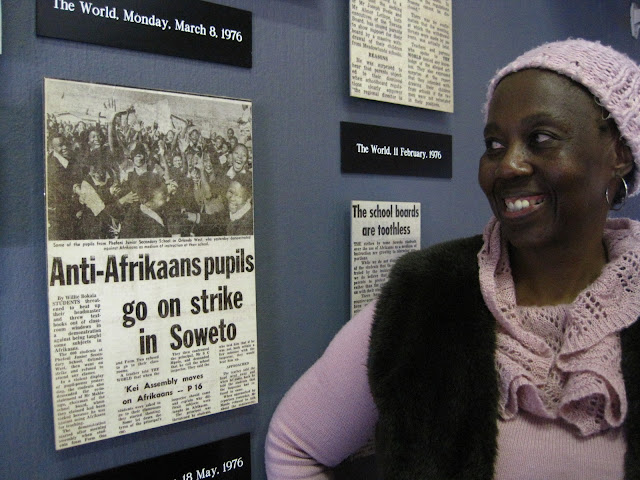Soweto (South Western Townships) is a township on the outskirts of Johannesburg. During apartheid, Black South Africans were forbidden from living in the city without permits, but their menial labor was vital to the day-to-day function of the city so they were kept in townships nearby.* Because the people living in the townships were poor, disease and crime were very common. Many people lived in government-built RDP houses, which are two-room structures (without bathrooms). RDP houses are still commonly found there, but many residents have added to their residences with additional structures. We had the opportunity to go inside one of them and while it was small, it did not feel so different from the inside of many American homes.
D first took us to see the Regina Mundi church, which was one of the centers of the anti-apartheid movement. Because political meetings were banned, activists used the church as a meeting place. Famed for the bullet holes sustained during the Soweto Uprising, the Reverend Jesse Jackson, the Clintons, and more recently Michelle Obama have given inspired speeches there.
The Soweto Uprising of 1976 began in response to a law declaring Afrikaans the language of instruction in all schools. Afrikaans (a Dutch-related language) was affiliated with the apartheid government, and was thus unpopular amongst the nation's Black population. D's friend from school told us what it was like after this law was passed. He said that one day he was learning chemistry in English, the next, without any Afrikaans instruction, his lesson was in Afrikaans. (Chemistry is hard enough, I thought.) Because it affected schoolchildren, the rally was organized and orchestrated by students. The plan was to march down the main street in Soweto until they arrived at Orlando Stadium. They didn't make it very far. Police soon set dogs on the children, and before long began shooting at them. Hundreds of people died.** The most famous victim was a 12-year old boy named Hector Pieterson, whose lifeless body was photographed and shown around the world.
We visited the Hector Pieterson Museum and Memorial,*** which provided a lot of interesting information about the education system in the townships and how the students were able to organize during that time. We also got a personal account from D, who had been a teenager during the Soweto Uprising, and had participated in it herself. She showed us something pretty special at the museum:
 |
| 15-year old D participating in the rally. |
Nelson Mandela and Desmond Tutu once lived on the same street in Soweto. That street is now a bit of a tourist attraction.
We ended the night with a trip to Soweto's first restaurant, Wandie's. Now also a major tourist attraction, Wandie's features the closest thing to real South African cuisine we found: samp and beans, an assortment of curries, and rice. Though a little pricey, it was delicious. The walls of the restaurant are covered in currencies from around the world so we added a dollar bill and wrote down our names and places of origin.
*For a (from what I've been told) accurate representation of an apartheid-era township, see the movie District 9, which was filmed in Soweto.
**Both White and Black.
***While I later visited the Apartheid Museum, which gives a much more in-depth perspective of apartheid, the images of this museum remain the most imprinted in my memory.








No comments:
Post a Comment